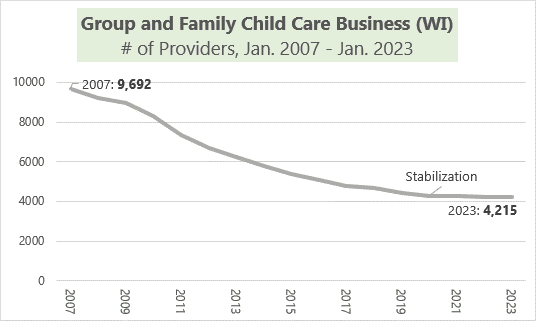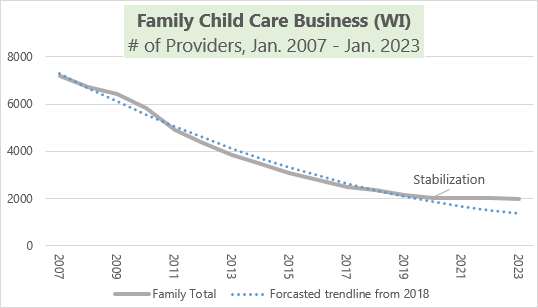4 takeaways about the high cost of child care in Wisconsin and nationwide
For Wisconsin families, child care can easily surpass housing costs, and even the cost of in-state college tuition. But as expensive as child care is in Wisconsin, it's even worse in other states.
This spring, Child Care Aware of America released 2022 data detailing the supply and cost of child care in all 50 states as part of its "Catalyzing Growth: Using Data to Change Child Care" series. In addition to pulling individual state's data, it also highlights national trends.
Here are some key takeaways from the report:
Child care is often the largest expense in Wisconsin households' budgets
In Wisconsin, the average annual price of center-based care for infants — typically the most expensive age group — was $13,572 in 2022. This equates to 12% of the median income of a married couple and 40% of the median income of a single-parent family.
For child care to be considered "affordable" by U.S. Department of Health and Human Services standards, child care for all children in a household should be no more than 7% of the household's income. Not a single state meets this threshold for center-based infant care when considering the median married couple's income, Child Care Aware of America's report shows.
Wisc. CC and other expenses
Infogram
As a child ages, the cost of care typically decreases. Even with lower rates for older children, child care in Wisconsin can still cost more than in-state tuition at University of Wisconsin-Madison, and child care for multiple children can make care costs surpass that of housing.
Center-based care is often more expensive than family child care, or child care businesses that are run out of providers' homes.
In an effort not to price families out of the market, Wisconsin child care providers often charge far less than what it actually costs to run a child care (including bills, adequate personnel compensation, food costs and more). This makes for what industry experts call a broken business model that leaves child care businesses struggling and often leaves child care workers workers with low wages.
More: The new Wisconsin family? 1.7 kids, no picket fence and child care costs more than college
Child care in Wisconsin is expensive, but other states see higher costs
CC costs Wisconsin and neighbors
Infogram
The average annual cost of center-based infant care in Massachusetts exceeds $24,000, making it the state with the most expensive care in this category. The state with the least expensive center-based infant care annual average is Mississippi ($7,280).
Although the dollar cost of this type of child care is highest in Massachusetts, families in Hawaii and New York devote a higher percentage of their income to center-based infant care (in both Hawaii and New York,18% of the median income of a married couple goes to this type of child care). In Massachusetts, this figure is 16%.
In Mississippi, 8% of the median income of a married couple goes to center-based infant care.
Center-based infant care in Wisconsin is less expensive than in Minnesota and Illinois, but more expensive than in Iowa and Michigan.
How does Wisconsin's child care supply compare to national trends?
Child Care Aware of America’s report draws on data from the Supporting Families Together Association to analyze Wisconsin’s child care supply in 2019-22.
While the report's numbers vary from figures compiled by Wisconsin’s Department of Children and Families, both data sets largely convey similar trends. DCF and SFTA explained the differences could be due to multiple factors, including when the data was collected; the SFTA data was collected early each year, while the DCF data looks at the number of child care programs throughout the whole calendar year.

According to both data sets, the number of licensed child care centers in Wisconsin decreased from 2021 to 2022. Nationally, that number increased during that time, and even surpassed pre-pandemic figures.
Max Luck, SFTA data specialist, pointed out the Wisconsin data shows a small decrease in child care centers from 2021 to 2022 (about a 0.5% decrease), which he said is within a normal fluctuation from year to year. The total number of 2022 group centers in Wisconsin is close to 2016’s figures.

Mirroring the national decline in regulated family child care programs, Wisconsin did see a decline in these programs from 2021 to 2022, according to both SFTA and DCF data. However, Luck said the decrease is much less than those seen year-to-year in the 2010s and reflects a stabilization since 2020.
But with pandemic-era support set to end in early 2024, this trend may not last.
Child Care Aware of America emphasizes the importance of investment
According to the Child Care Aware of America report, every state dedicated pandemic relief funding, as well as federal and state child care money, toward rectifying the child care crisis.
The report linked successes — namely the nation's supply of child care centers growth from 2021 to 2022 and the slowed rate of decline in the nation's supply of family child cares — to such investment.
However, it cautioned, "Without continued and increased funding for child care, the positive trends seen in 2022 will not continue — leaving families with fewer options for accessible, affordable and high-quality child care."
In Wisconsin, Child Care Counts, a stabilization payment program that is funded through pandemic relief dollars, is credited with keeping thousands of child care businesses open, and some providers used the funds to ward off steep tuition hikes. The program was not included in the 2023-24 state biennial budget, and is now set to end in early 2024.
The budget did include, however, $15 million for what Republicans on the Joint Finance Committee dubbed a "revolving loan fund" for child care providers. It's not clear yet whether this funding will be limited to only loans or whether it could ultimately be used for grants too. When the Joint Committee on Finance discussed this spending plan, Rep. Jessie Rodriguez, R-Oak Creek, said more will be revealed in upcoming proposed legislation.
More: Republican lawmakers block extending pandemic-era program Child Care Counts
Under the new budget, in 2024-25 the eligibility threshold for Wisconsin Shares, the state subsidy program aimed at helping families afford child care, will shift from 185% to 200% of the federal poverty level. The copayment structure will also change.
Gov. Tony Evers recently proposed a special legislative session, set for Sept. 20, in hopes of investing more in child care and extending Child Care Counts past early 2024. The state Legislature, controlled by Republicans, has no obligation to take up such legislation, and Republicans have already indicated they will gavel in and out of the proposed special session without doing so.
The Child Care Aware of America report suggested a number of ways to invest in the industry, from tackling how unaffordable care is for families to the national decline in family child care businesses. It also said additional investment could be used to reconcile the gap between the true cost of running a child care business and the price families can afford to pay for care.
Molly Beck of the Milwaukee Journal Sentinel contributed to this article.
Madison Lammert covers child care and early education across Wisconsin as a Report for America corps member based at The Appleton Post-Crescent. To contact her, email mlammert@gannett.com or call 920-993-7108. Please consider supporting journalism that informs our democracy with a tax-deductible gift to Report for America.
This article originally appeared on Appleton Post-Crescent: How much does child care cost in Wisconsin? Latest national trends.
